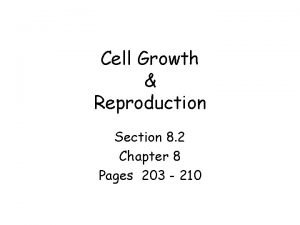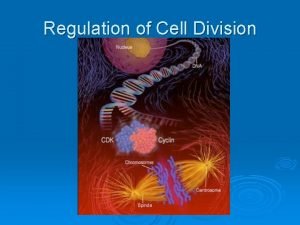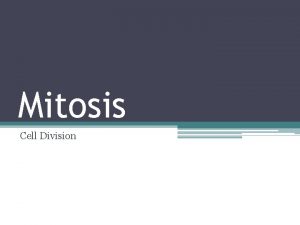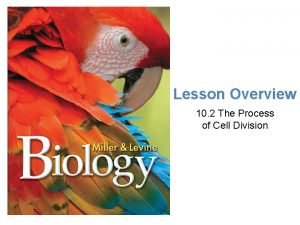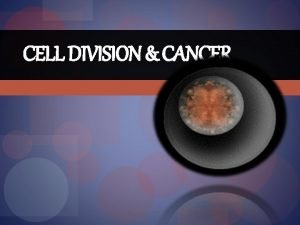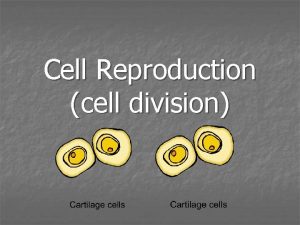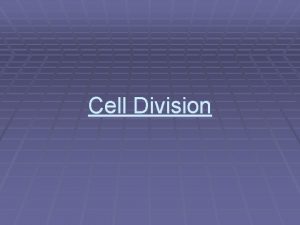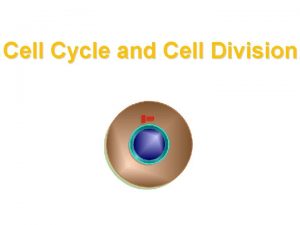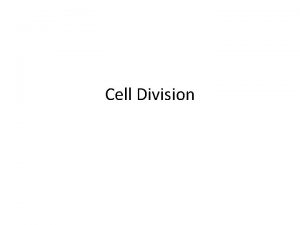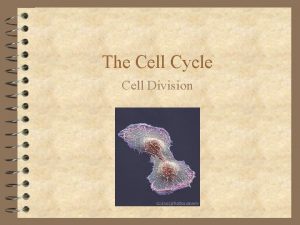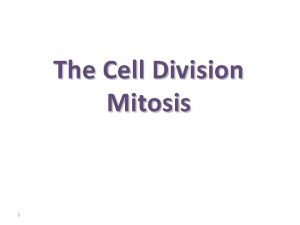Chapter 3 Cell Division 3 1 Cell division














- Slides: 14

Chapter 3: Cell Division 3. 1 Cell division occurs in all organisms 3. 2 Cell division is part of the cell cycle 3. 3 Both sexual and asexual reproduction involve cell division

3. 3 Both sexual and asexual reproduction involve cell division Multicellular organisms: cell division functions in growth, repair and development Unicellular organisms: each cell is itself and organism Cell division is to reproduce: asexual reproduction One organisms produces one or more new organisms that are identical to itself Paramecium (binary fission)

Asexual reproduction involved one parent Cells divide to produce two daughter cells When the cell is a whole organism, cell division = reproduction An offspring is produced – can live independently Identical to parent: parent’s genes = offspring’s genes “asexual reproduction”

Cell Division in Unicellular Organisms Cell division = one form of asexual reproduction Occurs in two ways, depending on nucleus or not Prokaryotes (no nucleus): Binary fission (asexual reproduction) parent organisms replicates its DNA then splits in two daughter cells offspring Ex: bacteria and archaea Eukaryotes Unicellular: reproduction by mitosis and cytokinesis Ex: algae , some yeasts, and protozoans such as paramecia

Budding Both unicellular and multicellualr organisms can reproduce using this method The organism develops tiny buds on its body – same genetic material as parent Most often, reaches a certain size and breaks away (can sometimes remain attached to parent) Some unicellular and some multicellular organisms reproduce by budding: In some multicellular: buds form from any cell of the body In other multicellular organisms, on specialized cells may bud How different in unicellular and multicellular organisms? In unicellular organisms, the bud is a single cell. In multicellular organisms, the bud grows by cell division, becoming multicellular

Regeneration The process in which missing body parts are replaced by the growth of new tissue Specialized cells at the site of a wound or lost limb are able to become different types of tissues Typically for regrowth of damaged or missing body parts Sometimes for asexual reproduction New organism is genetically identical to the original organism


Asexual Reproduction and Health How can you get so sick so fast? Bacteria are unicellular prokaryotes, reproduce by binary fission (can occur very fast!) Bacterial reproduce asexually through binary fission: 2 become 4 become 8… Generation time of bacteria is often very short: <30 minutes! After 24 generations…millions of bacteria! Some bacteria are good for your health


Sexual reproduction involves two parent organisms Cell division produces cells identical to the parent cell One organism can produce offspring through asexual reproduction Parent genetically identical to offspring Many multicelluar organisms reproduce by sexual reproduction Genes of two parents are combined to produce offspring Offspring are not exactly the same as either parent Diversity of life possible because of the combining of genetic materials from two parents in sexual reproduction Genes from the parents have to be combined in a way that gives the offspring the right number and types of genes to become the same type of organism

1. Cancer is a disease characterized by rapid, uncontrolled cell division. Explain why you think colchicine is sometimes used in cancer chemotherapy. 2. How would a colchicine-treated cell differ from a nontreated cell? 1. Colchicine can stop cancer cells from dividing. 2. The colchicine-treated cell would have twice as many chromosomes as a nontreated cell.


1. Suggest a reason why bacteria do not undergo mitosis. 2. Why are employees in the food service industry required to wash their hands frequently? 3. Why do you think it is important to defrost foods in the refrigerator instead of at room temperature?

Answers 1. Suggest a reason why bacteria do not undergo mitosis. 2. Why are employees in the food service industry required to wash their hands frequently? 3. Why do you think it is important to defrost foods in the refrigerator instead of at room temperature? 1. Bacteria have no nuclei or chromosomes, so they do not undergo mitosis when they divide. 2. To prevent the spread of bacteria 3. Refrigeration greatly slows the growth of bacteria.
 Cell cycle and cell division
Cell cycle and cell division Cell cycle and cell division
Cell cycle and cell division Phases of cell cycle
Phases of cell cycle Section 8-2 cell division
Section 8-2 cell division The scientist mathias schleiden studied _______ in ______.
The scientist mathias schleiden studied _______ in ______. Short division vs long division
Short division vs long division What is the missing number in the synthetic-division array
What is the missing number in the synthetic-division array Division is a repeated
Division is a repeated Sythetic division
Sythetic division Pmat
Pmat Frequency of cell division
Frequency of cell division Mitosis
Mitosis Why is cell division important
Why is cell division important What is metaphase plate
What is metaphase plate Ipmatc acronym ideas
Ipmatc acronym ideas



